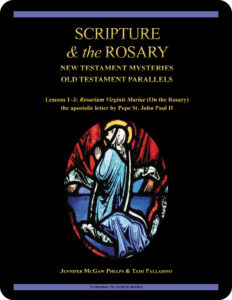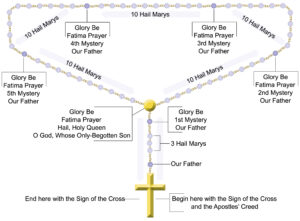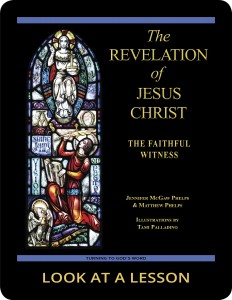 Scripture & the Rosary:
Scripture & the Rosary:
New Testament Mysteries,
Old Testament Parallels
Rosarium Virginis Mariae
Lesson 3 Assimilating the Mystery of Christ
Rosarium Virginis Mariae (chapter 3 & conclusion)
Revised Standard Version Catholic Edition (RSVCE)*
New American Bible Revised Edition (NABRE)*
Catechism of the Catholic Church
Rosarium Virginis Mariae (Rosary of the Virgin Mary)
ex libris (in our library)
cross references for Scripture & the Rosary
next lesson: God the Father: Creation & Faith
This material coordinates with Lesson 3 on pages 10–11 in Scripture & the Rosary: New Testament Mysteries, Old Testament Parallels.
And Mary said, “My soul magnifies the Lord, and my spirit rejoices in God my Savior,
for he has regarded the low estate of his handmaiden.
For behold, henceforth all generations will call me blessed;
for he who is mighty has done great things for me, and holy is his name.”
—the Gospel According to Luke 1:46–49
welcome to our in-depth study of Scripture & the Rosary
We invite groups and individuals to become acquainted with Turning to God’s Word Catholic Bible  studies through
studies through  Scripture & the Rosary: New Testament Mysteries, Old Testament Parallels, which has been granted an imprimatur. Although no longer available in print, the first six lessons can be downloaded from our website. The remaining 20 lessons are posted throughout the liturgical year along with their related online study pages. Click here to access Lesson 1 through Lesson 3. If you have a Bible-study question or comment, you can contact our authors any time by using one of the “ask us your question” or “what do you think” buttons on any online study page.
Scripture & the Rosary: New Testament Mysteries, Old Testament Parallels, which has been granted an imprimatur. Although no longer available in print, the first six lessons can be downloaded from our website. The remaining 20 lessons are posted throughout the liturgical year along with their related online study pages. Click here to access Lesson 1 through Lesson 3. If you have a Bible-study question or comment, you can contact our authors any time by using one of the “ask us your question” or “what do you think” buttons on any online study page.
open with prayer
It’s always wise to begin any Bible study with prayer, whether reading the Scriptures alone or meeting with others in a discussion group. You can pray using your own words or use one of the opening prayers on our website. We especially like the following:
Lord Jesus, you promised to send your Holy Spirit to teach us all things.
As we read and study your word today,
allow it to touch our hearts and change our lives. Amen.
 Gospel—you could look it up in our archives
Gospel—you could look it up in our archives
Most Catholics are aware that the word gospel means “good news.” Many even know what constitutes the good news of the Gospel. What is less well known is how the Rosary acts as a compendium of this good news. To learn more about the Gospel, read Lost in Translation, an online column in which Turning to God’s Word author Matthew Phelps helps readers connect with ideas expressed in the original languages of the Scriptures. New Lost in Translation entries are posted on Mondays, and past entries are archived on our website. Contact us if you’d like to receive Lost in Translation by email every week.
the popes inspire us—practical concerns about prayer
Lesson 3 in Scripture & the Rosary: New Testament Mysteries, Old Testament Parallels completes our reading of Rosarium Virginis Mariae (Rosary of the Virgin Mary), and the questions in this lesson are  based on material in the third chapter and the conclusion of that apostolic letter written by Pope St. John Paul II. As in the first two lessons, each of the bold-faced labels that introduces a question in this section in Scripture & the Rosary: New Testament Mysteries, Old Testament Parallels matches a subhead of the apostolic letter. Lesson 3 focuses on nitty-gritty practical concerns about a valuable method to use in praying the Rosary and addresses some specific situations in which Christians should turn to the Rosary. There are as many different ways to pray as there are individual Christians, but a few common denominators mark the circumstances in which we’re most likely to turn to God in prayer.
based on material in the third chapter and the conclusion of that apostolic letter written by Pope St. John Paul II. As in the first two lessons, each of the bold-faced labels that introduces a question in this section in Scripture & the Rosary: New Testament Mysteries, Old Testament Parallels matches a subhead of the apostolic letter. Lesson 3 focuses on nitty-gritty practical concerns about a valuable method to use in praying the Rosary and addresses some specific situations in which Christians should turn to the Rosary. There are as many different ways to pray as there are individual Christians, but a few common denominators mark the circumstances in which we’re most likely to turn to God in prayer.
WHAT DO YOU THINK about talking with God?
If most people are completely honest, there are many times when the very idea of speaking with God is a frightening prospect.
? What are some situations in which you’ve found yourself turning to God more frequently than usual?
? What kind of situations are you unlikely to discuss with God in prayer?
 ? What do you think might be the reason for your reluctance to discuss some topics?
? What do you think might be the reason for your reluctance to discuss some topics?
? How important is it to you that you have a close relationship with God?
? What can you identify as one thing standing in the way of more intimacy with God?
? What can you do to remove this obstacle?
? How is your memory tied to prayer?
? Think back to a time when you were able to engage in deep, focused prayer. What else was going on in your life then?
? What emotions best describe how you felt about your life at that time?
? Why do you think that you were able to focus so clearly on your prayer?
? What can you do to indicate to God that you have a sincere desire to be more open to his action in your life?
Q&A—repetition helps us learn Christ’s way of peace
A participant in this study has asked about how to defend the repetitive prayers of the Rosary.
 Q: How do Catholics explain the repetitious nature of the 10 Hail Marys? I get the premise of meditating on the life of Jesus—but are we asked to “multi-task” by saying 53 Hail Marys while thinking about different times in Jesus’ life? As many apologetics books as I’ve read, I’ve never understood how to defend the repetitious nature of all the Hail Marys.
Q: How do Catholics explain the repetitious nature of the 10 Hail Marys? I get the premise of meditating on the life of Jesus—but are we asked to “multi-task” by saying 53 Hail Marys while thinking about different times in Jesus’ life? As many apologetics books as I’ve read, I’ve never understood how to defend the repetitious nature of all the Hail Marys.
A: Probably the best apologetics answer about the repetitive nature of the Rosary prayers is found in these words from the introduction to this lesson: “It’s through the repetitive prayers of the Rosary that Christians learn Christ’s way of peace at the knee of their Mother, the Blessed Virgin Mary. All children learn through repetition and example. We pick up habits of love and peace by participating in the prayer of the Christian family.”
Your concern about multi-tasking is valid. It’s extremely easy to get wrapped up in trying to do a lot of things to draw nearer to God in prayer. In so doing, we sometimes can distance ourselves even further. The ultimate aim of prayer is contemplation, often referred to as “infused prayer.” We can’t make this type of prayer happen, but we can try to open our minds and hearts so that we’ll be paying attention when God reaches out to us.
The point of the Rosary Mysteries is to give us a structure on which to base our prayers. It isn’t necessary that we think too hard about all of the biblical details of the Mysteries at the same time that we’re praying. We can look at one thing about the Mystery we’ve chosen to pray and focus on that detail in a more general way. For example, the Mystery of the Crucifixion can trigger a background reflection on death, on the self-sacrifice of Jesus, on how Jesus’ suffering and death benefits humanity, and on whether there’s any way that we can participate in Jesus’ sacrifice. We can think about Jesus’ Mother standing at the foot of the cross. Knowing more about the biblical foundations of this Mystery allows us to broaden the possibilities of topics for meditation. We can think about the way in which Psalm 22 describes Jesus’ Crucifixion and about why it is that Jesus chose to quote from that Psalm as he was dying on the cross. We can think about how incredible it is that David was able to record this prophetic vision of the crucified Christ. We can think about the meaning of the skull and crossbones that appear at the bottom of the cross in so many depictions of the Crucifixion. We can think about why it is that a pelican is a symbol of Christ. We can think about the cross as the tree of life. And there are hundreds of other possibilities.
The more we know about the Mysteries of the Rosary, the more prepared we are to embrace the related images that come to us when we’re praying the repetitive prayers. We don’t have to try to think about everything we know about the Crucifixion to be sure we cover it all at the same time that we’re praying. The tendency to want to do that is a side-effect of our hyperactive society. Most of us don’t know how to sit quietly and meditate. The repetitive prayers of the Rosary encourage tranquility. Using the beads helps us to know where we are in our prayers and to pray in a serene and reverent way without having to worry about how many more Hail Marys we’ve left to say, or whether we’ve become distracted and lost track.
different ways to pray
What do you know about different ways of praying? “Expressions of Prayer” on page 11 in Scripture & the Rosary: New Testament Mysteries, Old Testament Parallels explains the underlying trait at the heart of all sincere prayer.
different verse numbering
The Book of Isaiah 9:6–7 cited on page 11 in Scripture & the Rosary: New Testament Mysteries, Old Testament Parallels  refers to translations of the Revised Standard Version Catholic Editions (RSVCE and RSV2CE). The corresponding verse in the New American Bible Revised Edition (NABRE) is the Book of Isaiah 9:5–6. You can learn more about the prophet known as Proto- (First) Isaiah in Lesson 20 Isaiah Foresees Immanuel’s Birth through Lesson 23 Hezekiah Consults Isaiah in the Turning to God’s Word Catholic Bible study Thus Says the LORD: God Speaks Through His Servants the Prophets—Volume I: A Kingdom Divided.
refers to translations of the Revised Standard Version Catholic Editions (RSVCE and RSV2CE). The corresponding verse in the New American Bible Revised Edition (NABRE) is the Book of Isaiah 9:5–6. You can learn more about the prophet known as Proto- (First) Isaiah in Lesson 20 Isaiah Foresees Immanuel’s Birth through Lesson 23 Hezekiah Consults Isaiah in the Turning to God’s Word Catholic Bible study Thus Says the LORD: God Speaks Through His Servants the Prophets—Volume I: A Kingdom Divided.
don’t forget about our indexes & extra online material

 If you’re trying to locate information about a Scripture passage, you can look it up in the index at the back of the online version of this study. If you want to revisit a commentary, you can look it up by title in the topics index. If you want to learn more about another book of the Bible for which there’s a Turning to God’s Word study, you can read online commentaries and watch any accompanying videos by choosing a lesson from one of the study directories. (There are no lesson videos with Scripture & the Rosary: New Testament Mysteries, Old Testament Parallels.) Finally, if you have a question or would like to make a comment about any of our studies, you can use the “ask us your question” or “what do you think” button to email our authors.
If you’re trying to locate information about a Scripture passage, you can look it up in the index at the back of the online version of this study. If you want to revisit a commentary, you can look it up by title in the topics index. If you want to learn more about another book of the Bible for which there’s a Turning to God’s Word study, you can read online commentaries and watch any accompanying videos by choosing a lesson from one of the study directories. (There are no lesson videos with Scripture & the Rosary: New Testament Mysteries, Old Testament Parallels.) Finally, if you have a question or would like to make a comment about any of our studies, you can use the “ask us your question” or “what do you think” button to email our authors.
ex libris—Church documents & books about religious topics
Link to magisterial documents referred to in our Bible studies at ex libris—magisterial documents.  This listing includes significant recent encyclicals as well as a number of historical Church documents. Recommended books related to Scripture study can be found at ex libris—main bookshelf.
This listing includes significant recent encyclicals as well as a number of historical Church documents. Recommended books related to Scripture study can be found at ex libris—main bookshelf.
pray the Rosary
 We invite you to pray the Rosary along with Turning to God’s
We invite you to pray the Rosary along with Turning to God’s  Word co-founder Tami Palladino and her daughter Anne Marie. Their videos are available on the online study pages for Lessons 7 through 26, and the Rosary prayers as well as the videos for all 20 mysteries are accessible year-round at how to pray the Rosary. Clicking on the diagram (right) will take you to the website page with the Rosary prayers. Watch Tami and Anne Marie’s how-to video (below) to learn more about praying the Rosary.
Word co-founder Tami Palladino and her daughter Anne Marie. Their videos are available on the online study pages for Lessons 7 through 26, and the Rosary prayers as well as the videos for all 20 mysteries are accessible year-round at how to pray the Rosary. Clicking on the diagram (right) will take you to the website page with the Rosary prayers. Watch Tami and Anne Marie’s how-to video (below) to learn more about praying the Rosary.
Lesson 4 God the Father: Creation & Faith—the book of Genesis 1:26–31, 18:2–5 and 18:8–10
Lesson 2 The Rosary: A Compendium of the Gospel—Rosarium Virginis Mariae (chapter 2)
you also may like our study of the book of Revelation
 The Revelation of Jesus Christ: The Faithful Witness, a 23-lesson Catholic Bible study with an imprimatur, examines ways in which our traditional Christian view of heaven is built on Hebrew apocalyptic visions recorded in the Old Testament. This recently revised study includes maps and additional commentary and takes a close look at the role of the prophets in present-day Christianity. Illustrations by Tami Palladino depict the often-misunderstood images in the book of Revelation. Click on the book’s cover to view a sample lesson.
The Revelation of Jesus Christ: The Faithful Witness, a 23-lesson Catholic Bible study with an imprimatur, examines ways in which our traditional Christian view of heaven is built on Hebrew apocalyptic visions recorded in the Old Testament. This recently revised study includes maps and additional commentary and takes a close look at the role of the prophets in present-day Christianity. Illustrations by Tami Palladino depict the often-misunderstood images in the book of Revelation. Click on the book’s cover to view a sample lesson.
start a Turning to God’s Word Bible study
 Thank you for your interest in Scripture & the Rosary: New Testament Mysteries, Old Testament Parallels.
Thank you for your interest in Scripture & the Rosary: New Testament Mysteries, Old Testament Parallels.  Information about beginning a Turning to God’s Word Bible study can be found at start a Bible study. Tami, Matthew, and I are available to answer your questions and to offer support. You may use this email to contact us directly if you’re interested in starting a Turning to God study or in having your study schedule listed with other TtGW study groups on our website. —Jennifer
Information about beginning a Turning to God’s Word Bible study can be found at start a Bible study. Tami, Matthew, and I are available to answer your questions and to offer support. You may use this email to contact us directly if you’re interested in starting a Turning to God study or in having your study schedule listed with other TtGW study groups on our website. —Jennifer
*There are seven deuterocanonical books in the Old Testament—the Books of Tobit, Judith, Wisdom, Sirach, Baruch, and First and Second Maccabees, as well as some passages in the Books of Esther and Daniel. Protestants usually refer to these works as “apocryphal,” a word that means “outside the (Protestant) canon” because they’re excluded from most Protestant Bibles. The word “deuterocanonical” means “second canon”; Catholics use that word to refer to any section of the Catholic Old Testament for which there are no extant, or existing, Hebrew manuscripts. All of the deuterocanonical books appear in the Septuagint, the earliest remaining versions of which date to the 1st century B.C. This Greek translation of the Old Testament was in common use by Jews at the time of Jesus—but the same books aren’t found in existing Hebrew manuscripts, which aren’t as old as the oldest version of the Septuagint. Learn more by reading How Do Catholic & Protestant Bibles Differ?
Turning to God’s Word printed Bible studies use the 2006 Revised Standard Version Second Catholic Edition (RSV2CE) translation for all Scripture references except those to the Psalms, which are taken from The Abbey Psalms and Canticles, prepared by the Benedictine monks of Conception Abbey and published in 2020 by the United States Conference of Catholic Bishops (USCCB). All Scripture links for the digital version of Scripture & the Rosary: New Testament Mysteries, Old Testament Parallels are to the 1966 Revised Standard Version Catholic Edition (RSVCE) translation. The New International Version (NIV) audio recordings follow the same chapter and verse numbering as the RSV Catholic translations, but the NIV translation doesn’t include the deuterocanonical books and passages.
The 1966 RSVCE uses archaic pronouns and verb forms such as “thee,” “thou,” “didst” in the Psalms and in direct quotations attributed to God. The 2006 RSV2CE replaces those with more accessible English. The few significant translation changes in the RSV2CE include rendering almah as “virgin” in the Book of Isaiah 7:14 and restoring the term “begotten” in the Gospel According to John 3:16.
Numbering varies for some passages in this Bible study. Turning to God’s Word studies follow the numbering in the Revised Standard Version Catholic translations (RSV2CE and RSVCE). Discrepancies in the New American Bible Revised Edition (NABRE) are noted in the Index of Scripture Citations.
 You can learn more about the Psalms by viewing a sample lesson from the Turning to God’s Word Catholic Bible study Sing a New Psalm: Communicating with God Through the Prayers of the Church—Volume I: Lauds & Vespers. The second part of that study, Sing a New Psalm: Communicating with God Through the Prayers of the Church—Volume II: Vigils, Day Prayer & Compline, is scheduled for publication in 2025. Some verse numbers may vary in different translations of the Psalms.
You can learn more about the Psalms by viewing a sample lesson from the Turning to God’s Word Catholic Bible study Sing a New Psalm: Communicating with God Through the Prayers of the Church—Volume I: Lauds & Vespers. The second part of that study, Sing a New Psalm: Communicating with God Through the Prayers of the Church—Volume II: Vigils, Day Prayer & Compline, is scheduled for publication in 2025. Some verse numbers may vary in different translations of the Psalms.
